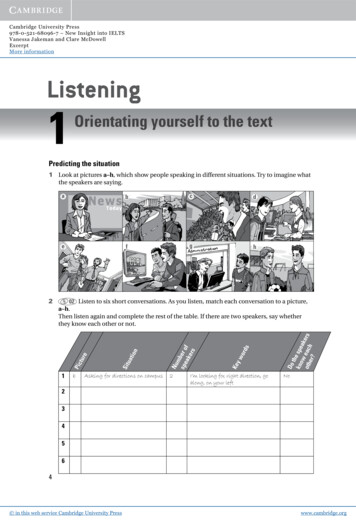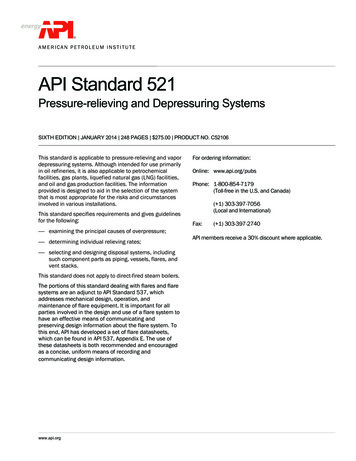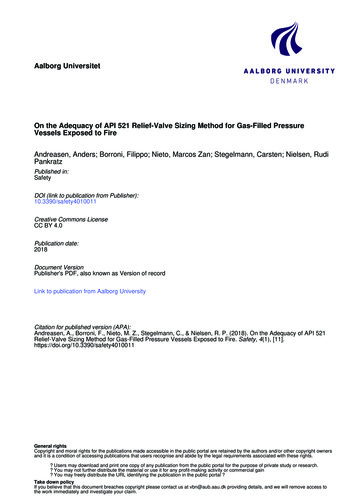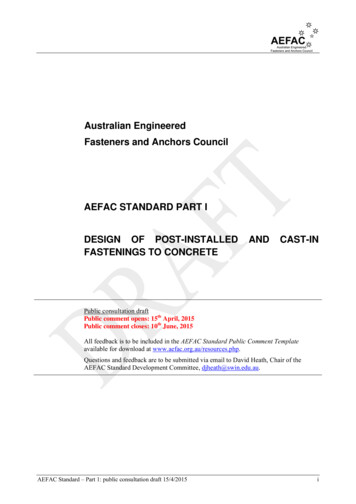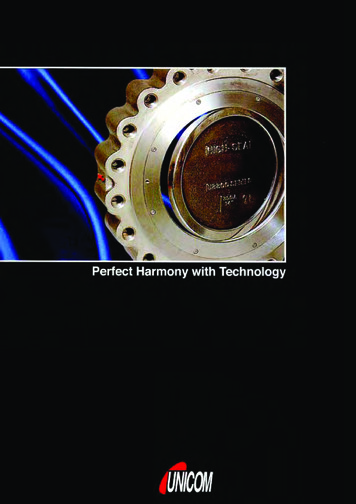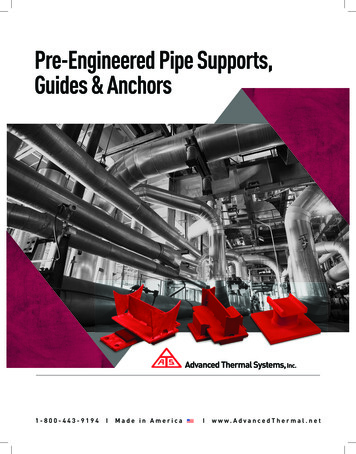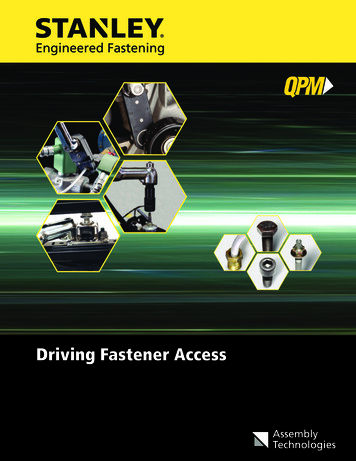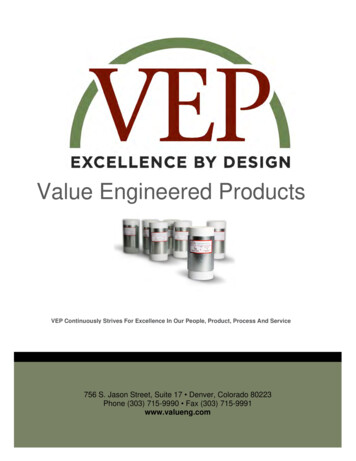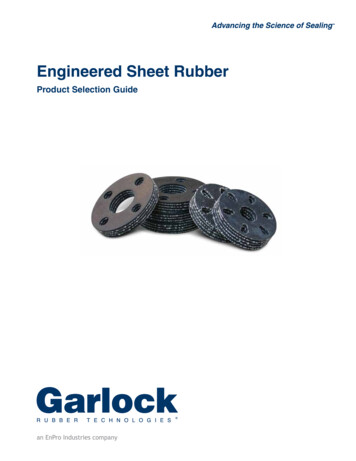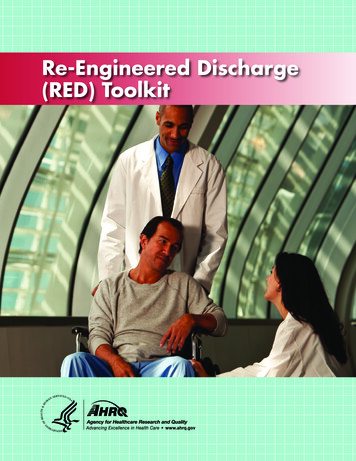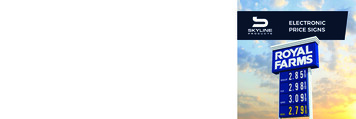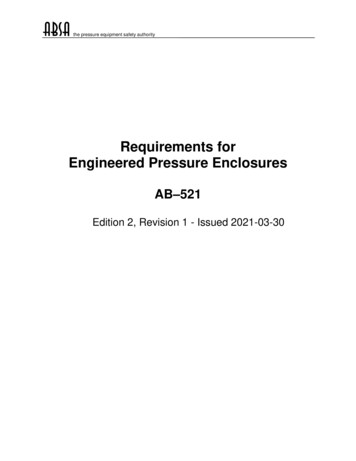
Transcription
the pressure equipment safety authorityRequirements forEngineered Pressure EnclosuresAB–521Edition 2, Revision 1 - Issued 2021-03-30
Requirements for Engineered Pressure EnclosuresTable of ContentsFOREWORD . iii1.0INTRODUCTION . 12.0SCOPE . 23.0DEFINITIONS AND ACRONYMS. 24.0REFERENCE PUBLICATIONS . 65.0REQUIREMENTS FOR THE USE OF EPE . 85.1 Registration Requirements . 85.1.1Fittings Design Registration Requirements . 95.1.1.1 EPE Fitting Registration Requirements . 105.1.2RRIMR Registration Requirements . 105.1.2.1 General Engineering Requirements (GER) form for the Use ofEPEs . 145.1.2.2 Risk Assessment . 165.1.2.3 Root Cause . 175.1.2.4 Installation Procedure . 175.1.2.5 Maintenance and Monitoring . 185.1.2.6 Removal of the EPE from the Piping System . 185.1.2.7 Specific Requirements for EPEs Installed in Boiler External Piping(BEP) . 185.1.2.8 Specific Requirements for EPEs Installed over Cracks . 195.1.2.9 Specific Requirements for EPE’s Installed over Local Thin Area 195.1.2.10 Other Requirements and Limitations . 215.2 Quality Control Program and Quality Management System Requirements . 225.2.1Requirements for the EPE Fitting Manufacturers . 225.2.2Requirements for the EPE Fitting Installers . 225.2.3Requirements for Installation of EPE . 225.3 Safety. 235.4 Removal of EPE . 235.5 Record Keeping Requirements for EPE Installations . 236.0THE STREAMLINED ACCEPTANCE PROCESS . 236.1 Streamlined Acceptance Process Scope . 246.2 Registration of EPE and RRIMR Requirements in the StreamlinedAcceptance Process . 256.2.1EPE Fittings registration for the Streamlined Acceptance Process. 256.2.2RRIMR Procedure Registration for the Streamlined AcceptanceProcess . 257.0SPECIFIC REQUIREMENTS FOR EPE’S INSTALLED ON PRESSUREVESSELS . 25Issued 2021-03-30AB–521 Edition 2, Revision 1i
Requirements for Engineered Pressure EnclosuresANNEX A: QUALITY PLAN REQUIREMENTS FOR AN ALBERTA OWNER-USERRRIMR PROCEDURE SUBMISSION. 27A-1.0INTRODUCTION . 27A-2.0OBJECTIVE . 27A-3.0SCOPE . 27A-4.0ELIGIBILITY . 28A-5.0RRIMR QP AND PEIM SYSTEM . 28A-6.0OWNER-USER RESPONSIBILITIES AND PROVISIONS . 28A-7.0MINIMUM RRIMR QP REQUIREMENTS . 29A-8.0EPE AND RRIMR FOR EXTENDED SERVICE LIFE . 30A-9.0APPLICATION AND RECOGNITION PROCESS . 32A-9.1A-9.2Application Process. 32Recognition Process . 32A-10.0 RRIMR QP AUDIT AND LETTER OF RECOGNITION . 338.0REVISION LOG . 34Issued 2021-03-30AB–521 Edition 2, Revision 1Page ii
Requirements for Engineered Pressure EnclosuresFOREWORDAs provided for under Section 40(4) of the Pressure Equipment Safety Regulation, theAdministrator in the pressure equipment discipline has issued an Information Bulletin toestablish that ABSA document AB-521, “Requirements for Engineered Pressure Enclosures”specifies requirements for the design, fabrication, installation, and removal of EngineeredPressure Enclosures (EPEs) in Alberta, and requirements for registration of enclosure designsand of associated procedures.This document also contains provisions for a streamlined acceptance process, allowingcollective pre-registration of enclosure designs when their use is limited to certain applications.It also includes Annex A that establishes the requirements for documenting and implementingthe Quality Plan for development and acceptance of an RRIMR procedure.The next reaffirmation of the AB-521 is scheduled for 2024.Issued 2021-03-30AB–521 Edition 2, Revision 1iii
Requirements for Engineered Pressure Enclosures1.0INTRODUCTIONAB-521 applies to EPEs typically used in pressure piping systems that are subject to thePressure Equipment Safety Regulation (PESR). In addition, AB-521 allows the limiteduse of EPEs for pressure vessels subject to the PESR.The PESR establishes requirements that must be met by persons who own, operate,design, construct, install, repair, alter or maintain pressure equipment or provide relatedservices to ensure that the pressure equipment is safe for operation.This ABSA requirements document was developed through close cooperation with plantowners, EPE manufacturers, other Jurisdictions and other stakeholders. Their input hasbeen invaluable in compiling this document.ABSA requirement documents are periodically reviewed to ensure that they are alignedwith current industry practice. We would welcome any suggestions you have to improvethis document.Please provide your comments to:Djordje Srnic,Manager, Codes & Standards&Assistant Chief InspectorEmail: Srnic@absa.caIssued 2021-03-30AB–521 Edition 2, Revision 1Page 1 of 34
Requirements for Engineered Pressure Enclosures2.0SCOPEFrom time to time, industries experience leaks on pressure equipment when it may beimpractical to shut down immediately for repair. An EPE (also called on-line leak sealingor leak box) provides a means of temporarily containing certain leaks until theequipment can be properly repaired. The pressure equipment owner is responsible fordetermining if the use of an EPE is appropriate for any given leak and if the installationof an EPE can be safely performed.The Codes and Standards referenced in the PESR and CSA-B51 do not give rules forEPEs. This document was developed in close cooperation between ABSA, industry andother Canadian Regulatory Authorities to provide guidance and consistency. Theintention of this document is to provide rules for the use of EPEs to seal leakingpressure equipment and to provide reinforcement to pressure equipment degraded bylocal corrosion or erosion.If there is a conflict between other ABSA documents for the design or construction orinstallation of EPEs in pressure equipment and this document, this document shallprevail.Caution: This document does not provide all the necessary information required toperform leak sealing of pressurized equipment. It is the responsibility of the owner, orany other organization that designs, manufactures or installs an EPE, to ensure that allof the necessary engineering, installation and safety requirements are addressed forany given installation.3.0DEFINITIONS AND ACRONYMSFor the purpose of AB-521, the following definitions and acronyms apply:ABSA – is the organization delegated by the Government of Alberta to administer thepressure equipment safety legislation under the Safety Codes Act.ABSA Safety Codes Officer (SCO) – means a safety codes officer, designated underthe Act, in the pressure equipment discipline. [PESR 1(1)(ee)]ABSA Design Surveyor – is an ABSA Safety Codes Officer (SCO) who holds therequired Safety Codes Officer designation and designated powers under the SafetyCodes Act and is competent to assess that the design of pressure equipment complieswith the Alberta Regulations and Code of construction requirements.Act and Regulations – means the Alberta Safety Codes Act and the followingregulations:- Pressure Equipment Exemption Order (Alberta Regulation 56/2006),- Pressure Equipment Safety Regulation (Alberta Regulation 49/2006),- Power Engineers Regulation (Alberta Regulation 85/2003),- Pressure Welders Regulation (Alberta Regulation 169/2002)Issued 2021-03-30AB–521 Edition 2, Revision 1Page 2 of 34
Requirements for Engineered Pressure EnclosuresAdministrator – means the Administrator in the pressure equipment disciplineappointed under the Act. [PESR, 1(1)(b)]Alteration – means any change to an item of pressure equipment as described in theoriginal manufacturer's data report that requires a change of design calculations orotherwise affects the pressure-containing capability of the item of pressure equipment.[PESR 1(1)(d)]Non-physical changes such as a change in the maximum allowable working pressure ordesign temperature of a boiler or pressure vessel pressure retaining item areconsidered alterations, as are reductions, such as reduction in minimum temperature.ASME Code – means the American Society of Mechanical Engineers (ASME) Boilerand Pressure Vessel Code or Pressure Piping Code declared in force applicable to theequipment. [PESR 1(1)(e)]BEP – means boiler external piping as defined in the ASME B31.1, Power Piping CodeBoiler – means a vessel in which steam or other vapour can be generated underpressure or in which a liquid can be put under pressure by the direct application of aheat source. [PESR 1(1)(f)]Category D Fluid Service – Fluid service as defined in the ASME B31.3, ProcessPiping CodeCertificate of Authorization Permit (CAP) – means a permit issued pursuant tosection 44 of the Act authorizing a person to carry out the activities stated on thecertificate of authorization permit. [PESR 1(1)(g)]Damage Mechanism – any type of deterioration encountered that can result in flaws ordefects that can affect the integrity of pressure equipment; for example, corrosion,cracking, erosion, dents, and other mechanical, physical, or chemical impacts.Engineered Pressure Enclosure (EPE) – is an enclosure used for containing a leak orreinforcing existing pressure equipment for a limited time until a proper repair oralteration is carried out.Fitting – means a valve, gauge, regulating or controlling device, flange, pipe fitting orany other appurtenance that is attached to, or forms part of, a boiler, pressure vessel,fired-heater pressure coil, thermal liquid heating system or pressure piping system.[PESR 1(1)(n)]General Engineering Requirements (GER) Form – means a form that providesgeneral engineering requirements for design and construction of an EPE.Issued 2021-03-30AB–521 Edition 2, Revision 1Page 3 of 34
Requirements for Engineered Pressure EnclosuresIntegrity Management System (IMS) – means a system for ensuring that pressureequipment is designed, constructed, installed, operated, maintained anddecommissioned in accordance with the Pressure Equipment Safety Regulation. [PESR1(1)(s)]Inspector – means an Owner's Inspector, an In-service Inspector, or an ABSA SafetyCodes Officer, who is responsible for inspecting and certifying the item of pressureequipment.Maximum Allowable Working Pressure (MAWP) – maximum allowable workingpressure means the pressure authorized on the design registration or a lesser pressureas indicated on the manufacturer’s data report. [PESR 1(1)(v)]MDMT – Minimum Design Metal TemperatureMOP – Maximum Operating PressureMOT – Maximum Operating TemperatureNondestructive Examination (NDE) – means any of a number of techniques that canbe used to examine a material, component, or system without causing damage.Common techniques include visual, ultrasonic, magnetic particle, liquid penetrant,radiographic, and eddy-current testing.Nonboiler External Piping – means piping as defined in the ASME B31.1, PowerPiping CodeNormal Fluid Service – Fluid service as defined in the ASME B31.3, Process PipingCodeOwner – includes a lessee, a person in charge, a person who has care and control anda person who holds out that the person has the powers and authority of ownership orwho for the time being exercises the powers and authority of ownership. [SCA 1(1)(v)]Owner-user – an owner that has provided an Integrity Management System inaccordance with the Pressu
Issued 2021-03-30 AB–521 Edition 2, Revision 1 Page 5 of 34 Piping Design Pressure – is the design pressure value of the piping system as listed in the line designation table that is registered with ABSA and it represents the pressure used in the design of a pressure piping component together with the coincident design metal temperature, for the purpose of determining the minimum .
